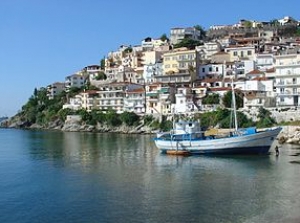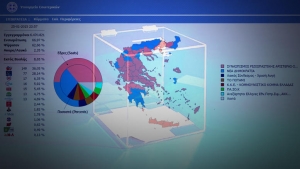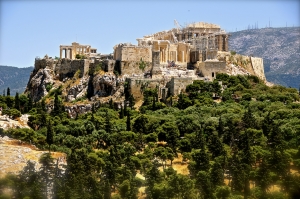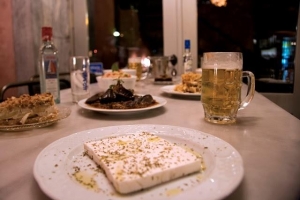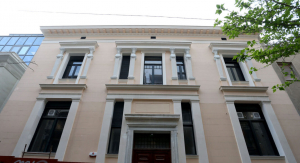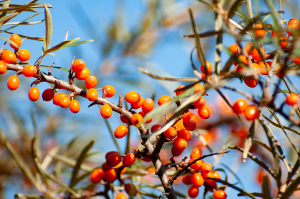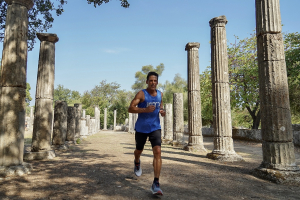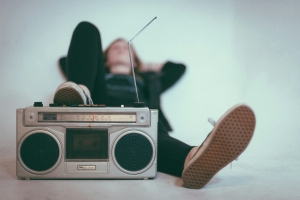XpatAthens
Kavala: The Blue City
The Monte Carlo of Greece, Greece’s Hidden Gem, The Blue City; just a handful of well deserved names which are often used by locals to describe the totally unspoilt and authentic city of Kavala which, in its amphitheatric setting, overlooks the Aegean Sea and the Island of Thassos, a forty five minute ferry trip away. Kavala is located in Macedonia, Northern Greece, approximately one hundred and sixty kilometers from Thessaloniki.
It is ideally located for access to Halkidiki, day trips to Thessaloniki, has a very reliable ferry network for Thasos, Lesvos, Samos and Samothraki and is just a twenty minute drive from the mountainous region of Pangaio, well worth a visit for its natural beauty including large expanses of forest, as well as for its monasteries and skiing during the winter.
The reason why people refer to Kavala as the Blue City is clear; the dramatic old town is built upon a rocky headland which is surrounded by the blue and turquoise colours of the Aegean, creating a stunning backdrop for a city and reflecting the Mediterranean sun onto the colourful houses.
The old town of Kavala was formerly a colony of Thasos and called Neapolis. It was significant both strategically and economically due to its proximity to the road which connects Thrace and Macedonia. It has been discovered that the first inhabitants of Neapolis came from Paros and Thasos. Being ideally positioned to confront invasions from Thrace, Kavala also functioned as a very important port linking the west and the east. This role would have begun around 650 BC. The city’s name then changed to Christoupolis under Byzantine rule and Kavala under Turkish occupation. Historically, Kavala has functioned as an important base for the tobacco trade, a key fishing port as well as being suitably located for the movement of gold from the Pangaio Mountain.
Upon visiting Kavala, one realises immediately how the development through many periods of history has created the modern city of Kavala, with constructions such as the Town Hall, a combination of traditional Greek and neoclassical architecture and the houses in the area of Panagia which were built by Greeks, Jews and Turks in the early twentieth century. The most symbolic constructions, however, are the Fortress (Frourio) and the Aqueduct (Camares), built by the Turks and the Venetians in AD 1425.
Kavala has an array of things to see and do, with a long coastline of white sandy beaches which begin at the ammolofoi, an area of sand dunes backing onto the region of vineyards just under twenty kilometres west of Kavala. As one heads closer towards the city, the fishing village of Iraklitsa offers a variety of Tavernas, all of which offer high quality seafood and mezedes, mainly catering for the local market. One of the most popular is Taverna Odysseas, located on the village promenade overlooking the small harbour.
The main road from Iraklitsa to Kavala meanders along the coastline between the mountains and the sea, with a continuous view of Fidonisi (Snake Island) and Thassos in the distance. (Photo-above left)
The most obvious place to visit in the city of Kavala is of course the fortress, with frequent live music performances as well as plays taking place during the summer, many of which are free of charge. Access to the fortress is through a cobbled street which runs through the old town past the old Turkish style houses.
In the local area any inquisitive visitor would find it hard to resist the urge to visit the ancient site of Philippi, one of the most important towns of Eastern Macedonia which had important privileges during Macedonian rule. However, the Battle of Philippi in 42 BC would lead to its transformation into a completely Roman town. The Apostle Paul baptized Agia Lydia, the first Greek female and European to be baptized by him, just a few minutes walk from Philippi.
For those with access to a vehicle, the region of the Nestos River is not to be missed due to its absolutely stunning natural beauty. (Photo-above center)
In all, Kavala can be described as a highly varied holiday destination with something to cater for the demands of every individual, ranging from beaches with crystal waters to Tavernas with live music as well as ancient sites and mountain hikes. What is more, this is a truly Greek working city and visitors will experience an authentic Greek way of life rather than any artificially created environment to cater specifically for tourists.
Author: George Howell
SYRIZA Heads For Historic Victory But Without Majority
SYRIZA was on the verge of a historic election victory on Sunday night but one that might not hand the leftist party an outright parliamentary majority, raising doubts about whether a government can be formed in the next few days.
With 70 percent of the votes counted at around midnight, SYRIZA held 36 percent and New Democracy 28.2. This would give SYRIZA 149 seats in Parliament, two short of a majority. The two parties were followed by Golden Dawn on 6.4 percent, Potami on 5.9 and the Communist Party (KKE) on 5.4. PASOK and Independent Greeks also looked certain to enter Parliament, both with close to a 4.7 percent share of the vote.
George Papandreou’s Movement of Democratic Socialists (Kinima) appeared set to miss out on a place in Parliament as it was under the 3 percent threshold for gaining seats, with 2.4 percent.
This means that SYRIZA leader Alexis Tsipras is likely to receive a three-day exploratory mandate from President Karolos Papoulias on Monday. If Tsipras cannot form a government, the mandate will pass to New Democracy for three days and then the third party for another three. However, as SYRIZA receives a 50-seat bonus for coming first, the other parties will not have enough seats to create a majority coalition and second elections would be needed, as in 2012.
To read more, please visit ekathimerini.com
Longer Hours & Pricier Tickets At Greek Museums & Archaeological Sites
In addition to the new hours, the Greek Ministry of Culture has announced a series of ticket price hikes for sites and museums including the Athens Acropolis, where general admission has now risen to 20 euros (from 12 euros), the Knossos archaeological site on Crete, where entrance now costs 15 euros (from 6 euros), the Sounio archaeological site, with tickets costing 8 euros (previously 4 euros), and the Epidaurus site and museum, which now cost 12 euros to visit (from 6 euros).
Authorities have also announced that the cloakroom at the Athens Acropolis will not be operating for security reasons for the time being, but visitors can enter the site with a small backpack or handbag.
Top Things To Eat And Drink In Athens
To read this article in full, please visit: On Board
Street Soccer 5x5 - SNFCC
Design-Implementation: Regeneration & Progress
When: Saturday 12, 19, 26/01 & Sunday 13, 20, 27/01
Time: 10.00 - 13.00
OUTDOOR GAMES AREA
Up to 10 children per 30' session
How To Stop Feeling So Busy All The Time
The frantic rhythms of daily life often make us feel exhausted, draining our energy, making us function almost mechanically, striving to make time for everything and fulfill all of our obligations. In fact, connectivity is responsible for this situation because it makes us feel that we need to be alert at all times, with tons of redundant notifications bombarding us non-stop.
All of the above lead to us constantly feeling busy and not being able to devote time to ourselves. But are we really that busy? Maybe the problem lies in the way we manage our time. Below, let's see some tips on what we can do to give our brain and body a chance to reset, restore, and cope with the stresses of everyday life!
Realize That Time Is Limited
No matter how hard we try to do everything, the day only has 24 hours. We have to come to terms with the fact that time is a precious yet limited commodity, and we cannot change that. It is also important to come to terms with our human nature - we are not superheroes, and we can not do everything. If we do not accept the above, we will be in a constant state of anxiety, trying to do much more than we can actually do, undermining our productivity and the quality of the result of our efforts.
Prioritize Work
It is crucial to have a clear picture of what needs to be done and when. Sure, every task is important, but some tasks are just more important than others. First, we deal with what needs to be done immediately and leave the rest for later if there is any time left. We don’t need to force ourselves to work on something that can be done at a later time when we will be less busy and able to focus exclusively on it.
Don’t Rush Things
When we feel really busy, it makes sense to try to do everything as fast as we can. However, rushing things leads to mistakes, which will create more stress, and we will also have to fix them, which will ultimately cost us more time.
Schedule Extra Time
Things usually take longer than we expect. So, we make sure that we always schedule extra time for tasks that could need more time. And, if the project didn’t require that extra time, we can use it for other tasks or for a much-needed break!
Give Time Away
Devoting some of our valuable time to a good cause, such as spending time with family or helping a friend in need, can actually help us be more productive. This is because subconsciously doing something successfully, such as advising a friend, works as a confirmation of our potential and our self-worth.
The Ziller-Loverdou Palace Opens Its Doors To Visitors
Originally posted in Greek on huffingtonpost.gr
Translated by Codico Lab
The Superfood That Fueled Alexander The Great
The small orange-yellow berries are described as a superfood. They are full of vitamins, antioxidants, and fatty acids that have been shown to aid in hair and nail growth, benefit eye health, and even boost the immune system as well as increase concentration.
Ancient Greek figures in pharmacology, medicine, botany, and nutrition have long been known for the healing, beneficial qualities of the sea buckthorn berries.
Alexander the Great ate the superfood
Alexander the Great noticed the beneficial qualities of the sea buckthorn berries superfood during his military campaigns in the then known world which he incorporated into his own diet as well as the diet of his troops to give them strength and vitality.
According to ancient sources, the famed Greek leader noticed that his horses loved the berries, and after eating them, they had more strength, shinier hair, recovered more quickly from injury and illness, and seemed to radiate health.
It’s from Alexander that sea buckthorn berries got their scientific name, Hippophae, which comes from the Ancient Greek words hippos and phaos, meaning “shining horse,” referring to the radiant effect the berries had on his horses.
To read this article in full, please visit: greekreporter.com
Greek Running Tours - The Ultimate Runcation
Photo Credit: Angelos Zymaras
The Healing Power Of Music
Originally published in Greek on: loveyourselfmagazine.com

Love Yourself is a comprehensive Greek media platform dedicated to embracing mindstyle as its fundamental essence. It advocates for a wholesome lifestyle that nurtures not only our soul, mind, and body but also promotes a positive and sustainable attitude towards the planet we call home. For more information, visit Love Yourself's website!


